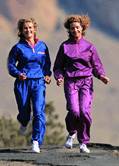 |
 |
 |
||
    |
||||
|
||||

Winter's Cold, Summer's Heat Take a Toll
Activity level drops among women at certain times of year, study finds|
|
HealthDay
By Robert Preidt
Friday, February 13, 2009
 FRIDAY, Feb. 13 (HealthDay News) -- Seasonal changes can interfere with people's attempts to get regular exercise, suggests a U.S. study that found that women work out more in the summer and less in the winter.
FRIDAY, Feb. 13 (HealthDay News) -- Seasonal changes can interfere with people's attempts to get regular exercise, suggests a U.S. study that found that women work out more in the summer and less in the winter.
The study involved 508 postmenopausal women whose physical activity levels were monitored for 18 months. Based on pedometer readings, the women's step counts averaged more than 7,000 a day in the summer, but declined nearly 2,000 steps in the winter.
"We've long suspected that seasons influence physical activity levels," study author Mark Newman said in an American College of Sports Medicine news release. "It's natural to want to stay indoors more during colder months, leading to fewer opportunities to be physically active, which in turn may negatively affect health."
But cold weather wasn't the only cause of seasonal fluctuations in exercise. Women who lived in regions that have extremely hot summers recorded lower activity levels during that season, the study reported.
The participants were divided into two groups of physical activity counseling -- lifestyle intervention and health education. Newman and his colleagues found that lifestyle intervention, which included a physical activity component, helped keep activity levels stable throughout the year. Compared with those in the health education group, women in the lifestyle intervention group had little variation in month-to-month step counts.
The study was published in the February issue of the journal Medicine & Science in Sports & Exercise.
Women 45 to 64 years old, the age range of the study participants, "have some of the lowest reported activity levels of any population subgroup out there," Newman said. "It's ironic, because physical activity is critical at this age to optimize functionality and health during the aging process."
HealthDay
Copyright (c) 2009 ScoutNews, LLC. All rights reserved.
Related News:
More News on this Date
Related MedlinePlus Pages:
| Home | Health Topics | Drugs & Supplements | Encyclopedia | Dictionary | News | Directories | Other Resources | |
| Disclaimers | Copyright | Privacy | Accessibility | Quality Guidelines U.S. National Library of Medicine, 8600 Rockville Pike, Bethesda, MD 20894 National Institutes of Health | Department of Health & Human Services |
Date last updated: 16 February 2009 |
